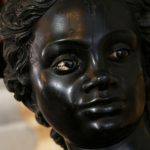African Venice is the title of a book recently published in Italian and in English by wetlands and edited by Paul Kaplan and Shaul Bassi.
The book is thought to be a guidebook, helping you retrace the history, art and culture of Africa in Venice. Ten itineraries guiding you throughout an African Venice of the past and present times, intertwined with a variety of different contributions by scholars, art historians, novelists and poets; some are African and Afro-descendant authors.
All talking about blackness in Venice, something you would imagine you would notice without any aid, but which is in fact kept quite invisible. This book is a magnifying lens through which you can see Venice in a different perspective. Even for the ones living in Venice who have grown accustomed and cannot “see” the African presence.
It was a honor and a true pleasure to interview Paul Kaplan who has been focusing on this subject for a long time.
An Interview to Paul Kaplan on African Venice
Q: How did the idea of a guidebook on African Venice start?
A: My scholarly research has been dedicated to Africans in Italian and European art since the 1980s. In 2002 I learnt Fred Wilson had been chosen as the artist for the 50th Venice Biennale US Pavilion in 2003 and I was happy to offer some help. I then started compiling the list of art pieces in the Venetian school representing African figures so that he could choose which ones to work on. As a matter of fact, also because of the short time he was given, he eventually picked up only some, applying a collage and reconstruction process. Francesco Guardi’s oil painting featuring Lazzaro Zen was one of the few he managed to borrow. The Pesaro Tomb at the Frari was the inspiration for a rethinking of the façade of the US Pavilion. The work was entitled “Speak of Me as I Am”, quoting Shakespeare’s Othello.
Five or six years ago I talked to Shaul Bassi about a project on African Venice. The list was already there. All art works of the Venetian school —very long, a few hundreds! — but how to organize such material? The idea of possible itineraries across Venice was the way we could invite visitors to see all these paintings or statues.
In fact, I always wanted to write a guidebook, but it wasn’t until I met Luca Cosentino at wetlands publishers that the idea of a book became real. He is a very attentive person to Venice and its environment and yet we realized how black figures had made little impression on him, too. Luca showed enthusiasm for this project quite quickly. He started pushing a year ago and the book “African Venice” was ready in a few months.
Q: You mention the incredible wide variety of representations of Blacks in Venice: why do you think Venice offers a multifaceted view of Blackness?
A: Venice was a port city and it had to be open to the world.
Also, we need to think of the connection with the Byzantine world. In the 11th century the Byzantine Empire developed a kind of propaganda imagery where it showed how they ruled over a multi-ethnic society, including Africa. Blackness has a strong visual impact and the presence of Africans in the arts was a way to signify the entire world was within the reach of the Roman Eastern Empire.
Venice represented itself as a rival of Byzantium and it picked up this aspect, too. A great example is the Pentecost dome in St Mark’s basilica of the 12th century, also featuring a couple of Egyptians in their dark skin. It surely represented the world the Apostles would convert, but it had a political significance, too.
Venice is then not immune to other representations of Blackness. So, even in St Mark’s church, Blacks appear as the torturer/executioner of the evangelist St Mark —and this is an idea of Venice, also applied elsewhere in medieval western Europe (France, for example), but not coming from Byzantium.
When in the 15th century the black population in Venice became quite present, then the representation of Africans became even more complex as the result of being in contact with real people, when human attachment came into play. It was most slaves, but not just, also black gondoliers serving at the traghetto.
Finally, let’s not forget the influence of German art on Venetian art when representing the Black Magus at Epiphany in the arts.
Q: Venice was a multi-ethnic city which starting in the 15th century allowed foreign communities arrange fraternities. However you point out that no such an organization of Black people was present in Venice. Why?
A: Most of the Africans arrived in Venice as slaves, so they could not have an organization. Also, if the population had been larger, then there could have been an impetus to create a black confraternity like in Sicily or in some parts of southern Spain in order to control them. Instead, after surging around 1470, it then dropped off in the 1520s. The role of domestic slavery in Venice declined.
Q: Why did it decline?
A: Because most of the black slave market addressed the New World. Even if the route from Nigeria to Libya and then to Europe still functioned, it was less and less relevant. Moreover, the cost of a slave increased: in the 17th and 18th century in Venice only considerably wealthy people could afford a black slave.
Q: In your essay you talk about the Venetian tradition of making wooden statues of Africans, clearly enslaved as collars or chains appear. You add that “unfortunately” they are still being made in Venetian workshops, “along with glass versions and cast-bronze door-knockers and also earrings embellished with African heads”. What would you tell Venetians who instead think this is a historical tradition that should be kept?
A: Because it was a demeaning thing from the very beginning… Legally a slave is already a “thing”, and these objects are replacements of a person, a human being who had already been reduced to merchandise, Marx would call a “fetish”. They are beautifully crafted, no question about it.
In 2015 I was for a conference in Florence, where they also keep this tradition quite alive. We visited a workshop of wood carvers and asked them who would buy these blackamoors. The answer was that around 30 years ago (mid 1980s), it would be Americans. Then, more recently, late 1990s, Russians. Now it’s mainly people from the Gulf States where workers from South Asia often serve the ruling elite. You can see the politics in this! Don’t you think this conflicts with contemporary politics of human rights?
Q: Who is the audience for this guidebook on African Venice?
A: Venetians readers, an anglophone audience, a lot of different people. But I had in mind in particular African American tourists, visiting Venice and discovering this overwhelming Black presence which deserves attention, observation and helps understand Venice in depth.
A final consideration on African Venice
I hope you’ve enjoyed the interview as you will enjoy the book on African Venice. Sifting the city in search of signs, whatever they can be, artworks, beads, plants, in different sites, museums, palaces, churches, cafes, this book provides you with a physical and mental map that helps you understand that wherever you are in Venice, African Venice haunts you.
It definitely brings on the foreground a presence which is clearly overwhelming, but which lies in the background, sometimes invisible, simply decorative, sometimes a massive presence, but controlled and enslaved.
Maybe after exploring the city with this different guidebook, Venice will look different, for you, too.
by Luisella Romeo
registered tourist guide in Venice, Italy
www.seevenice.it
Here’s the link to a previous article of my blog about blackamoors: www.seevenice.it/en/blackamoors-in-paintings-sculptures-and-jewels-of-venice/
Learn about the next conference in Venice on Black Portraitures, Shifting Paradigms: www.blackportraitures.info/bp-venice/













